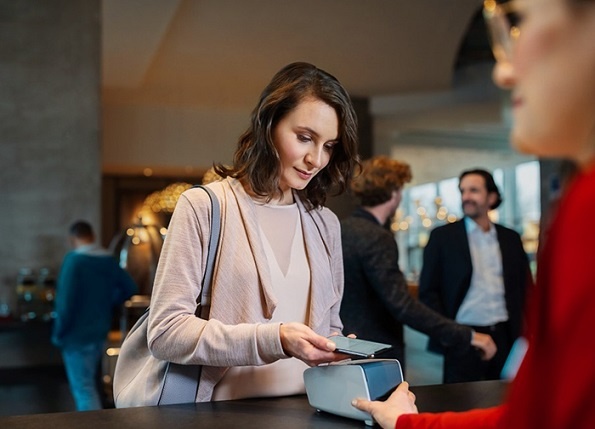Digital, Flexible, Contactless, and Seamless — a “Touchless Traveler Experience” is the New Normal for Business Travelers

By HRS
The Coronavirus pandemic is moving more and more focus to digital processes—a direction that is completely changing the way people travel. The new “Touchless Traveler Experience” is not only in the interests of travelers, but also of corporations sending employees back on the road.
How COVID-19 is Shining a Spotlight on Digital and Contactless Processes
Business travelers are eager to get back on the road, but the way they travel will fundamentally change in light of the coronavirus pandemic. The travel experience is no longer just about value for money; it must be digital, flexible, and, above all, contactless. But what does the “touchless traveler experience” everyone is talking about actually look like? And why do companies also have a part to play in this new way of traveling?
Working from home rather than traveling for work was and still is the status quo for most employees. So much so that, for a while, many travel sector experts were unsure when and how business travel would resume after or indeed during COVID-19. Some insiders even questioned whether there is a future for business travel at all. However, industry concerns are proving to be increasingly unjustified, because numerous surveys are now showing—in the truest sense—where travel is headed.
Travelers and Travel Managers Continue to Prefer In-Person Meetings
According to a recent survey, “Chefsache Business Travel 2020 (Business Travel Management Matters 2020),” an initiative by the German Travel Association (DRV), 85% of all employees in Germany still prefer in-person meetings, believing that they cannot be replaced by a virtual discussion. Although the 100 managing directors, business leaders and professionals with 250 or more employees regularly travel, they still regard virtual meetings as having been helpful during the coronavirus pandemic. Almost half of those surveyed believe that they generate a higher turnover through in-person meetings.
These figures apply outside Germany as well and show that business travelers around the world are eager to get back on the road. In Austria, in a survey conducted by Business Travel Unlimited (BTU), over 81% said that business travel continued to be “very important” or “important.” According to TravelpoolEurope (TPE), 67% of those surveyed in June said that they would “definitely” travel again on business. Travel managers in the USA, Asia, and Europe are also suggesting that the hotel industry can start to breathe a sigh of relief. In a survey by the Morgan Stanley Consulting Group, 41% of participants indicated that they were “very unsure” whether services such as Zoom could replace in-person meetings in the medium term.
The Touchless Traveler Experience — a Greater Priority for Travelers Than Ever Before
It is clear, then, that business travel will continue to be important and that it will largely bounce back. Similarly, it is also clear that the way in which we travel will change. A survey by HRS shows that business travelers’ priorities have shifted since the outbreak of the coronavirus pandemic. Value for money has been replaced as a key criterion for choosing a hotel by health and safety, and therefore contactless travel. Everyone is suddenly talking about the touchless traveler experience, but what does it actually look like, and what benefits does it offer?
1.Digital Experience — Booking Through to Payment
The times when business travelers used phones to book a hotel room are long gone. The younger generation, in particular, has grown up with technology and relies on using online booking tools, making them accustomed to seeing suggestions for alternative products, just like when they are shopping online. So it seems an obvious choice to use the same approach to recommend hotel rooms to millennials — who now account for over 50% of business travelers. The key to this type of convenient one-click experience is a recommendation engine that memorizes the user’s criteria and uses automated data analysis to identify hotels they have booked previously.
Booking criteria have changed fundamentally as a result. Before the outbreak of the coronavirus pandemic, room price and services such as breakfast and free WiFi were the key criteria for choosing a hotel. Nowadays, health and safety are taking center stage. In future, travelers will exclusively search for and book hotels that meet the latest safety standards and hygiene provisions. Needless to say, these criteria should also be made visible in digital booking channels.
But a search and booking process that makes it as easy as possible for travelers to find the right hotel is just the first step in the digital user experience. Smart solutions let travelers check in and out using their smartphone or PC, and virtual payment solutions mean contact with hotel reception staff is unnecessary. What’s more, guests receive their invoice via email rather than in paper form, which is ideal for travelers.
2. A Flexible Experience — Preparing for Unforeseen Events
There is no end in sight for the coronavirus pandemic. Although many countries have reopened their borders and loosened restrictions, everyone still fears a second wave — including travelers, of course. This means that people searching for the right hotel are looking for maximum flexibility so they can change their booking, or cancel it if necessary. In the long term, hotels that offer appropriate room rates will be the only ones to enjoy high occupancy levels.
3. A Contactless Experience — Checking In and Out via an App
The key to a contactless experience is having the right payment method. As described above, data entered by guests when booking is transferred to the hotel to minimize contact with front-of-house staff at check-in. Ideally, travelers will also receive a virtual key in the form of a barcode, which they can use to enter their room. And of course, the same rules apply to checking out: travelers should be able to check out with one click in the app. Smart hotels already have the ability to create a digital list of additional services, such as drinks and snacks from the minibar, so that they appear later on a guest’s invoice — an invoice they now receive by email rather than at reception, of course.

4. A Seamless Experience — Expense Reports Reinvented
Offering the right payment method is not only a prerequisite for contactless travel, but also makes life easier for business travelers after their stay. Since 85% of business travelers want a simple expense reporting process, according to a survey by GBTA and HRS, companies would be well-advised to choose an appropriate payment method. Invoices should be checked in line with the company travel policy and subsequently digitized to guarantee automated and efficient sales tax refunds for international trips. Travelers can enjoy a seamless travel experience and, in doing so, save hassle as well as time.
Contactless Travel Is Also in the Interest of the Company
Business travelers are not the only people to benefit from new, optimized experiences; employers can also use this new way of traveling as an opportunity to design their hotel program accordingly. With duty of care for their employees in mind, the coronavirus pandemic has given companies an even greater interest in ensuring that their travelers book within the prescribed channels. This can only be achieved, however, if smart solutions are used for booking processes and companies choose a payment method that solves the greatest problem in this industry: leakage, i.e. booking hotels outside of the managed channels.






Responses